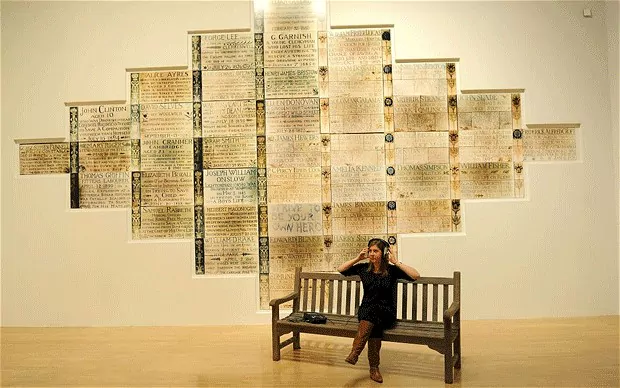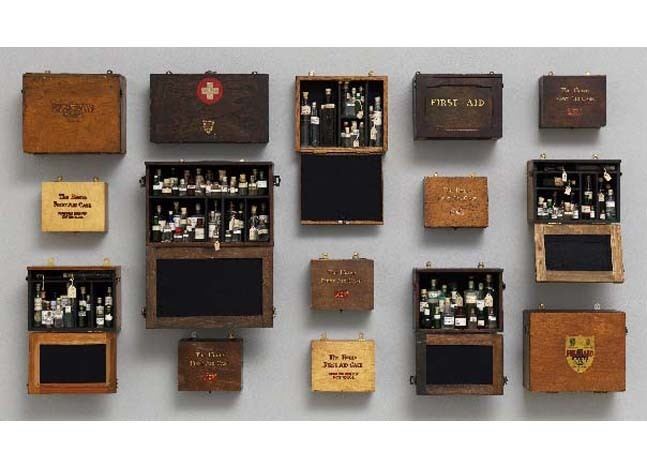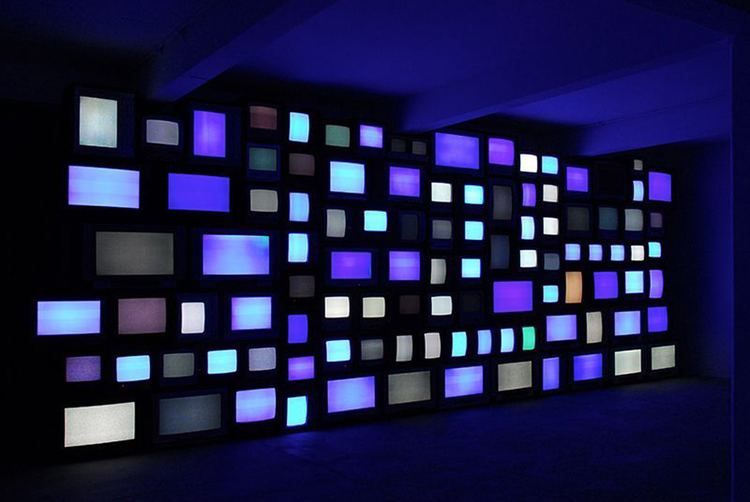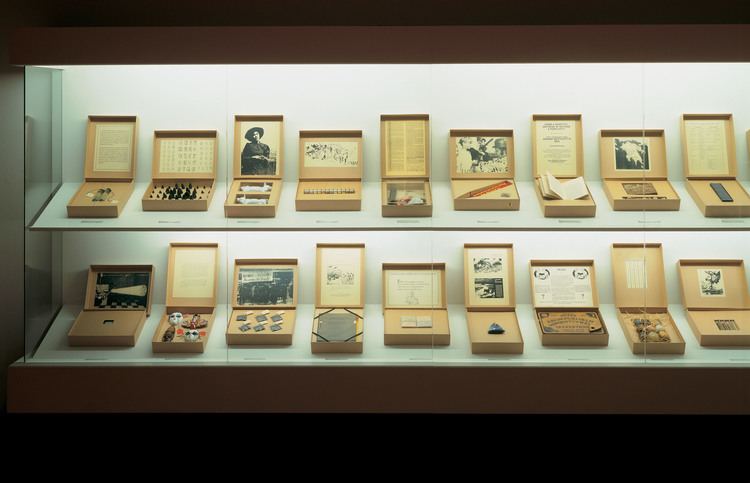Nationality American Name Susan Hiller | Role Artist Period Contemporary art | |
 | ||
Books Myth of Primitivism, Auras: Homage to Marcel Duchamp Awards Guggenheim Fellowship for Creative Arts, US & Canada | ||
Exhibition preview susan hiller
Susan Hiller (born 1940) is an American-born artist who lives in London, UK. Her art practice includes installation, video, photography, performance and writing.
Contents
- Exhibition preview susan hiller
- Andrea lissoni about susan hiller at far
- Early life and education
- Artistic career
- Collections
- Art fellowships and awards
- Key works 19702010
- Artists Books
- Catalogues
- References

Andrea lissoni about susan hiller at far
Early life and education

Born in Tallahassee, Florida in 1940, Susan Hiller was raised in and around Cleveland, Ohio. She later moved to Coral Gables, Florida in 1950 where she attended Coral Gables High School, graduating in 1957. She attended Smith College in Northampton, Massachusetts and received a B.A. in 1961. After spending a year in New York studying photography, film, drawing and linguistics, HIller went on to pursue a post-graduate degree at Tulane University in New Orleans, Louisiana with a National Science Foundation Fellowship in Anthropology. She completed a Ph.D. in Anthropology in 1965.

After doing fieldwork in Mexico, Guatemala and Belize, with a grant from the Middle American Research Institute (1962-5), Hiller became critical of academic anthropology; she did not want her research to be part of the "objectification of the contrariness of lived events [that was] destined to become another complicit thread woven into the fabric of 'evidence' that would help anthropology become a science". It was during a slide lecture on African art, that Hiller decided to become an artist. She felt art was "above all, irrational, mysterious, numinous … [she] decided [she] would become not an anthropologist but an artist: [she] would relinquish factuality for fantasy". This decision to begin an art practice was an effort, as the artist later recalled, to "find a way to be inside all my activities."
Artistic career

Beginning her artistic practice in the early 1970s, Hiller was influenced by the visual language of Minimalism and Conceptual art and now cites Minimalism, Fluxus, Surrealism and her study of anthropology as major influences on her work.

Hiller's first exhibition was a group show at Gallery House in London in 1973. There she presented two works, one under her own name and one using the pseudonym 'Hace Posible' (Spanish for 'make it possible') Transformer, 1973, a floor to ceiling grid structure with tissue paper covered with the artist's marks,and Enquires,1973, a slide show of facts collected from a British encyclopaedia meant to emphasize culturally partisan definitions in what is considered an objective and equitable source of information Her artistic practice was innovative for her time and included a variety of media and performance-based work. In the early 1970s Hiller created participatory 'group investigations' including Pray/Prayer (1969), Dream Mapping (1974) and Street Ceremonies (1973). These works originated in her conviction that "art can function as a critique of existing culture and as a locus where futures not otherwise possible can begin to shape themselves."

Over the course of her career, Hiller is known for making use of everyday phenomena and cultural artefacts from our society, drawing inspiration from sources as diverse as postcards, dreams, automatic writing, archives, Punch & Judy shows, UFO sightings, horror movies and narratives. Using the techniques of collecting and cataloguing, presentation and display, she transforms these everyday ephemera into art works that offer a means of exploring the inherent contradictions in our collective cultural life, as well as the individual and collective unconscious and subconscious. As an artist, she is interested in the areas of our cultural collective experience that are concerned with devalued or irrational experiences: the subconscious, the supernatural, the surreal, the mystical and the paranormal. She engages with these experiences and phenomena that defy logical or rational explanation through the rational scientific techniques of taxonomy, collection, organization, description and comparison. She does not, however, apply systems of judgment to the work, refraining from ever categorising the experiences as 'true' or 'false', 'fact' or 'fiction'.
Hiller describes her practice as 'paraconceptual' a neologism that places her work between the conceptual and the paranormal. Many of her works explore the liminality of certain phenomena including the practice of automatic writing (Sisters of Menon, 1972/79; Homage to Gertrude Stein, 2010), near death experiences (Clinic, 2004) and collective experiences of unconscious, subconscious and paranormal activity (Dream Mapping, 1974; Belshazzar's Feast, 1983-4; Dream Screens, 1996; PSI Girls, 1999; Witness,2000). Borrowing strategies from Minimalism to apply a "rational" framework to these products of the unconscious, the artist mounted the work in four L-shaped frames that, when installed on the wall together with four individually framed pages of her own commentary, make a cruciform. Hiller also published Sisters of Menon as an artist's book. She insisted on blurring the boundaries between cultural definitions of "rational" and "irrational," at the same time reinstating the validity of the unconscious as source of knowledge or truth.
After the mid-1970s, Hiller continued her engagement with Minimalism. For 10 Months (1977–79), she took photographs of her pregnant body and kept a journal documenting the subjective aspects of her pregnancy. The final work comprises ten gridded blocks of twenty-eight black and white photographs, each block corresponding to a lunar month. The images are accompanied by excerpts from her journal entries for the same period. These components are installed on the wall in a stepped pattern that descends from left to right. As Lisa Tickner observed, "The sentimentality associated with images of pregnancy is set tartly on edge by the scrutiny of the woman/artist who is acted upon, but who also acts: who enjoys a precarious status as both the subject and the object of her work...The echoes of landscape, the allusions to ripeness and fulfillment, are refused by the anxieties of the text, and by the methodical process of representation." The work was considered controversial when first exhibited in London.
Since the 1980s, Hiller has incorporated the use of audio and visual technology as a means of investigating these phenomena, allowing the visitor to 'make visions from ambiguous aural and visual cues'. In describing Hiller's work, Art Historian Dr. Alexandra Kokoli notes that "Hiller's work unearths the repressed permeability ... of ... unstable yet prized constructs, such as rationality and consciousness, aesthetic value and artistic canons. Hiller refers to this precarious positioning of her oeuvre as 'paraconceptual,' just sideways of conceptualism and neighbouring the paranormal, a devalued site of culture where women and the feminine have been conversely privileged. Most interestingly, in the hybrid field of 'paraconceptualism,' neither conceptualism nor the paranormal are left intact ... as ... the prefix 'para' -symbolizes the force of contamination through a proximity so great that it threatens the soundness of all boundaries."
Collections
Hiller's works are included in both international public and private collections including the Centre Pompidou, Paris; Tate Gallery, London.; Colby College Museum of Art, Colby, Maine; Ella Fontanals Cisneros Foundation, Miami; Frac Bourgogne, Dijon; Henie –Onstad Kunstsenter, Oslo; Henry Moore Sculpture Collection, Leeds; Inhotim, Brumadhino, Brazil; Israel Museum, Jerusalem; Ludwig Museum, Cologne; Moderner Museet, Stockholm; National Gallery of Art South Australia, Adelaide; Rhode Island School of Design Museum, Providence, Rhode Island; Smith College Museum of Art, Northampton, Massachusetts; Tokyo Metropolitan Museum of Photography; Victoria and Albert Museum, London.
Art fellowships and awards
Hiller has lectured at the Slade School of Fine Art, London and has served as 'Distinguished Visiting Professor' at California State University (1988) and as 'Visiting Professor' at the Department of Art at the University of California, Los Angeles (1992).
Key works (1970–2010)
Artist's Books
Rough Sea, Gardner Arts Centre Gallery, University of Sussex, Brighton, 1976; 56 b/w illus.
Enquiries/Inquiries, Gardner Arts Centre Gallery, University of Sussex, Brighton, with The Arts Council of Great Britain 1979; texts as illus.
Sisters of Menon, Coracle Press for Gimpel Fils. London 1983; facsimile of handwritten texts and charts as illus. hand painted board covers.
After the Freud Museum, Book Works, London, 1995. Reprinted 2000; 79 b/w illus. cover, text by Susan Hiller
Witness, Artangel, London 2000; 21 b/w and col. illus.
Split Hairs: The Art of Alfie West, self-published, Berlin, 2004, co-authored with David Coxhead, 9 col. illus.
The J. Street Project 2002-2005, Compton Verney, Warwickshire, and Berlin 2005; 303 col. illus. Intro. by Susan Hiller, afterword by Jörg Heiser (text in English and German)
Levitations:Homage to Marcel Duchamp, Institute of Contemporary Arts with Book Works, London 2008; 70 b/w and col. illus., text by Susan Hiller.
Catalogues
Susan Hiller, From Here to Eternity, essays by Richard Grayson, Jörg Heiser and Ellen Seifermann. Published by Verlag für moderne Kunst on the occasion of the exhibition at Kunsthalle Nürnberg, 10 December 2011 – 19 February 2012.
